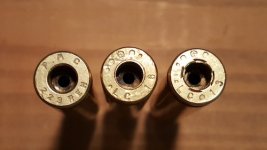I recently picked up a couple hundred rounds of 223/556 brass at a local range. Some of them are marked PMC 223 while the others are all marked with LC headstamps. My question is about the primer pockets. It is my understanding that the LC stamps are 556 military and the primer pockets need to be swaged. I picked up LC stamps LC09, LC13, LC14, LC15 and LC16. The primer pockets in the LC13 stamps have a different crimp that is much more pronounced than all of the others.
The primer pockets in the 223 and LC stamps all measure .175" except for the LC13 stamps, which measure .171"-173".
I have also read that the military brass will need to have the primer pockets swaged to accept new primers.
Would all of the LC stamp cases need to be swaged or just the LC13 stamps? I included a picture of the 3 if that will help.
The primer pockets in the 223 and LC stamps all measure .175" except for the LC13 stamps, which measure .171"-173".
I have also read that the military brass will need to have the primer pockets swaged to accept new primers.
Would all of the LC stamp cases need to be swaged or just the LC13 stamps? I included a picture of the 3 if that will help.

